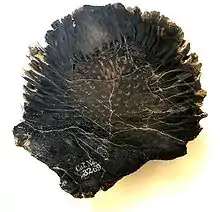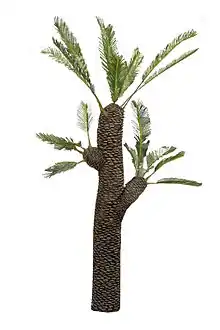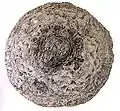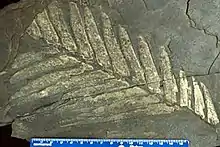Bennettitales
Bennettitales (also known as cycadeoids) is an extinct order of seed plants that first appeared in the Permian period[1] and became extinct in most areas toward the end of the Cretaceous (i.e. they existed from about 252 to 66 million years ago),[2] although some Bennettitales appear to have survived into Oligocene times in Tasmania and eastern Australia.[3] Bennettitales are among the most common extinct Mesozoic seed plants, and had morphologies including shrub and cycad-like forms. The order comprises two families, the Cycadeoidaceae, represented by Cycadeoidea and Monanthesia, and the Williamsoniaceae including Williamsonia, Williamsoniella, Wielandella and Ischnophyton which had slender, branching trunks and either bisporangiate or monosporangiate strobili.[4]
| Bennettitales | |
|---|---|
 | |
| A Cycadeoid, showing an "inflorescence" in the top-right | |
 | |
| Life restoration of Williamsonia | |
| Scientific classification | |
| Kingdom: | |
| (unranked): | |
| Division: | Cycadeoidophyta |
| Order: | Bennettitales † |
| Families | |
Description
Originally, Bennettitales were thought to be cycads for their strap-like leaves, however their flower-like reproductive parts separate the two groups. The two families of Bennettitales (Cycadeoidaceae and Williamsoniaceae) each have their own unique traits. Cycadeoidaceae had stout trunks and bisporangiate strobili (cones) serving as their reproductive structures and Williamsoniaceae either had bisporangiate or monosporangiate cones, and distinctly slender and branching woody trunks.[5] These bisporangiate cones consist of layers of protective bracts, a curved microsporophyll, and an ovulate receptacle.[6] The bisporangiate cones remained closed at maturation, and most likely were obligate self-fertilizers.[7]
In general, Bennettitales had leaves attached adaxially (toward the stem) with a distinct midrib. Veins stem from the midrib at an approximately 90 degree angle.[8] They have tough cuticles as well, as they were able to withstand high sulfur dioxide levels in the Triassic/Jurassic period for considerable time.[9] Some were characterized by thick trunks and pinnately compound leaves that bore a superficial resemblance to those of cycads, differing primarily in having a syndetocheilic stomatal arrangement.[10]
A study on members of Williamsoniaceae found that they had a divaricate branching habit, similar to that of Banksia, which was suggested to be an adaption to open habitats with poor soil nutrient conditions.[11]
The reproductive structures of some Bennettitales are flower like and were probably pollinated by insects. Several groups of Jurassic and Early Cretaceous insects possess long proboscis, and it has been suggested that these groups were feeders on nectar produced by bennettitalean reproductive structures. A specimen of the extinct long proboscis fly family Zhangsolvidae has been found directly associated with Bennettitales pollen, providing evidence that this family acted as pollinators for the group.[12]
Taxonomy
Bennettitales were first identified by Engler in 1892 as separate from Cycadales, and were then further differentiated into the two groups Cycadeoidaceae and Williamsoniaceae by Caruthers. The Anthophyte hypothesis erected by Arber and Parking in 1907[13] posited that angiosperms arose from Bennettitales, as suggested by the wood-like structures and rudimentary flowers.[5] Based on morphological data, however, Bennettitales were classified as a monophyletic group when paired with Gnetales.[14] a study in 2006 suggested that Bennettitales, Angiosperms, and Gigantopteridales form a clade based on the presence of oleanane.[15] A 2007 study examining phase-contrast X-ray images of gymnosperm seeds suggested that the supported the Anthophyte hypothesis.[16] Evidence from seed coats suggest that Bennettitales form a clade with the gymnosperm orders of Gnetales and Erdtmanithecales.[17] Molecular evidence has consistently contradicted the Anthophyte hypothesis, finding that Angiosperms are the sister group to all living gymnosperms, including Gnetales.[18] It has been suggested that Williamsoniaceae are a paraphyletic assemblage of Bennettitales that do not belong to the Cycadeoidaceae.[11]
Evolutionary history
The affinities of Bennettitales to other seed plants remains uncertain, a phylogeny based on molecular signatures of fossilised cuticles found that Bennettitales were more closely related to the Ginkgo+Cycads clade than conifers, and were closely related to Nilssonia and Ptilozamites.[19] The oldest known remains of Bennettitales are from the Late Permian (likely Changhsingian) aged Umm Irna Formation in Jordan, assignable to the leaf morphogenus Pterophyllum.[1] Bennettitales became widespread during the Triassic Epoch. Bennettitales remained widespread during the Jurassic and Early Cretaceous, however Bennettitales severely declined during the Late Cretaceous, coincident with the rise of flowering plants, being mostly extinct by the end of the period, with the final known remains from the Northern Hemisphere being found in the polar latitude Kakanaut Formation in Chukotka, Russia, dating to the Maastrichtian, also assignable to Pterophyllum.[20] The latest known remains of the family are from the early Oligocene of Eastern Australia and Tasmania, assignable to the genus Ptilophyllum.[3]
Gallery
 A fossilised Bennettite, squashed by later compression.
A fossilised Bennettite, squashed by later compression. Side view. Note embedded "flowers".
Side view. Note embedded "flowers". A flower-like structure.
A flower-like structure. Fossil leaf of Zamites mariposana from the Jurassic.
Fossil leaf of Zamites mariposana from the Jurassic.
References
- Blomenkemper P, Kerp H, Abu Hamad A, DiMichele WA, Bomfleur B (December 2018). "A hidden cradle of plant evolution in Permian tropical lowlands". Science. 362 (6421): 1414–1416. doi:10.1126/science.aau4061. PMID 30573628.
- Foster CS (2016). "The evolutionary history of flowering plants" (PDF). Journal and Proceedings of the Royal Society of New South Wales. 149: 65–82.
- McLoughlin S, Carpenter RJ, Pott C (April 2011). "Ptilophyllum muelleri (Ettingsh.) comb. nov. from the Oligocene of Australia: last of the Bennettitales?". International Journal of Plant Sciences. 172 (4): 574–85. doi:10.1086/658920.
- Speer BR (2000). "Introduction to the Bennettitales".
- Speer BR (2000). "Introduction to the Bennettitales".
- Arens NC, Stromberg C, Thompson A. "Introduction to the Bennettitales". University of California Museum of Paleontology. Retrieved 16 April 2018.
- Osborn JM, Taylor ML (2010). "Pollen and coprolite structure in Cycadeoidea (Bennettitales): implications for understanding pollination and mating systems in Mesozoic cycadeoids". Plants in deep Mesozoic time: morphological innovations, phylogeny, and ecosystems. Bloomington, IN: Indiana University Press. pp. 34–49. ISBN 978-0-253-00199-3.
- Ray MM, Rothwell GW, Stockey RA (September 2014). "Anatomically Preserved Early Cretaceous Bennettitalean Leaves: Nilssoniopteris corrugata n. sp. from Vancouver Island, Canada". Journal of Paleontology. 88 (5): 1085–93. doi:10.1017/S002233600005767X – via ResearchGate.
- Steinthorsdottir M, Elliott-Kingston C, Bacon KL (March 2018). "Cuticle surfaces of fossil plants as a potential proxy for volcanic SO2 emissions: observations from the Triassic–Jurassic transition of East Greenland". Paleobiodiversity and Paleoenvironments. 98: 49–69. doi:10.1007/s12549-017-0297-9.
- Pigg K (2005). "The Cycads, Cycadeoids (Bennettitales) and Ginkgophytes". Arizona State University. Archived from the original on 26 December 2007. Retrieved 21 September 2007.
- Pott, Christian; McLoughlin, Stephen (2014-06-01). "Divaricate growth habit in Williamsoniaceae (Bennettitales): unravelling the ecology of a key Mesozoic plant group". Palaeobiodiversity and Palaeoenvironments. 94 (2): 307–325. doi:10.1007/s12549-014-0157-9. ISSN 1867-1608.
- Peñalver E, Arillo A, Pérez-de la Fuente R, Riccio ML, Delclòs X, Barrón E, Grimaldi DA (July 2015). "Long-Proboscid Flies as Pollinators of Cretaceous Gymnosperms". Current Biology. 25 (14): 1917–23. doi:10.1016/j.cub.2015.05.062. PMID 26166781.
- Arber EN, Parkin J (July 1907). "On the Origin of Angiosperms". Botanical Journal of the Linnean Society. 38 (263): 29–80. doi:10.1111/j.1095-8339.1907.tb01074.x.
- Crane PR (September 1985). "Phylogenetic relationships in seed plants". Cladistics. 1 (4): 329–348. doi:10.1111/j.1096-0031.1985.tb00432.x.
- Taylor DW, Li H, Dahl J, Fago FJ, Zinniker D, Moldowan JM (March 2006). "Biogeochemical evidence for the presence of the angiosperm molecular fossil oleanane in Paleozoic and Mesozoic non-angiospermous fossils". Paleobiology. 32 (2): 179–90. doi:10.1666/0094-8373(2006)32[179:BEFTPO]2.0.CO;2.
- Friis EM, Crane PR, Pedersen KR, Bengtson S, Donoghue PC, Grimm GW, Stampanoni M (November 2007). "Phase-contrast X-ray microtomography links Cretaceous seeds with Gnetales and Bennettitales". Nature. 450 (7169): 549–52. doi:10.1038/nature06278. PMID 18033296.
- Friis EM, Crane PR, Pedersen KR, Bengtson S, Donoghue PC, Grimm GW, Stampanoni M (November 2007). "Phase-contrast X-ray microtomography links Cretaceous seeds with Gnetales and Bennettitales". Nature. 450 (7169): 549–52. doi:10.1038/nature06278. PMID 18033296.
- Ran JH, Shen TT, Wang MM, Wang XQ (June 2018). "Phylogenomics resolves the deep phylogeny of seed plants and indicates partial convergent or homoplastic evolution between Gnetales and angiosperms". Proceedings. Biological Sciences. 285 (1881): 20181012. doi:10.1098/rspb.2018.1012. PMC 6030518. PMID 29925623.
- Vajda, Vivi; Pucetaite, Milda; McLoughlin, Stephen; Engdahl, Anders; Heimdal, Jimmy; Uvdal, Per (August 2017). "Molecular signatures of fossil leaves provide unexpected new evidence for extinct plant relationships". Nature Ecology & Evolution. 1 (8): 1093–1099. doi:10.1038/s41559-017-0224-5. ISSN 2397-334X.
- Gnilovskaya, Anastasia A.; Golovneva, Lina B. (February 2018). "The Late Cretaceous Pterophyllum (Bennettitales) in the North-East of Russia". Cretaceous Research. 82: 56–63. doi:10.1016/j.cretres.2017.09.013.